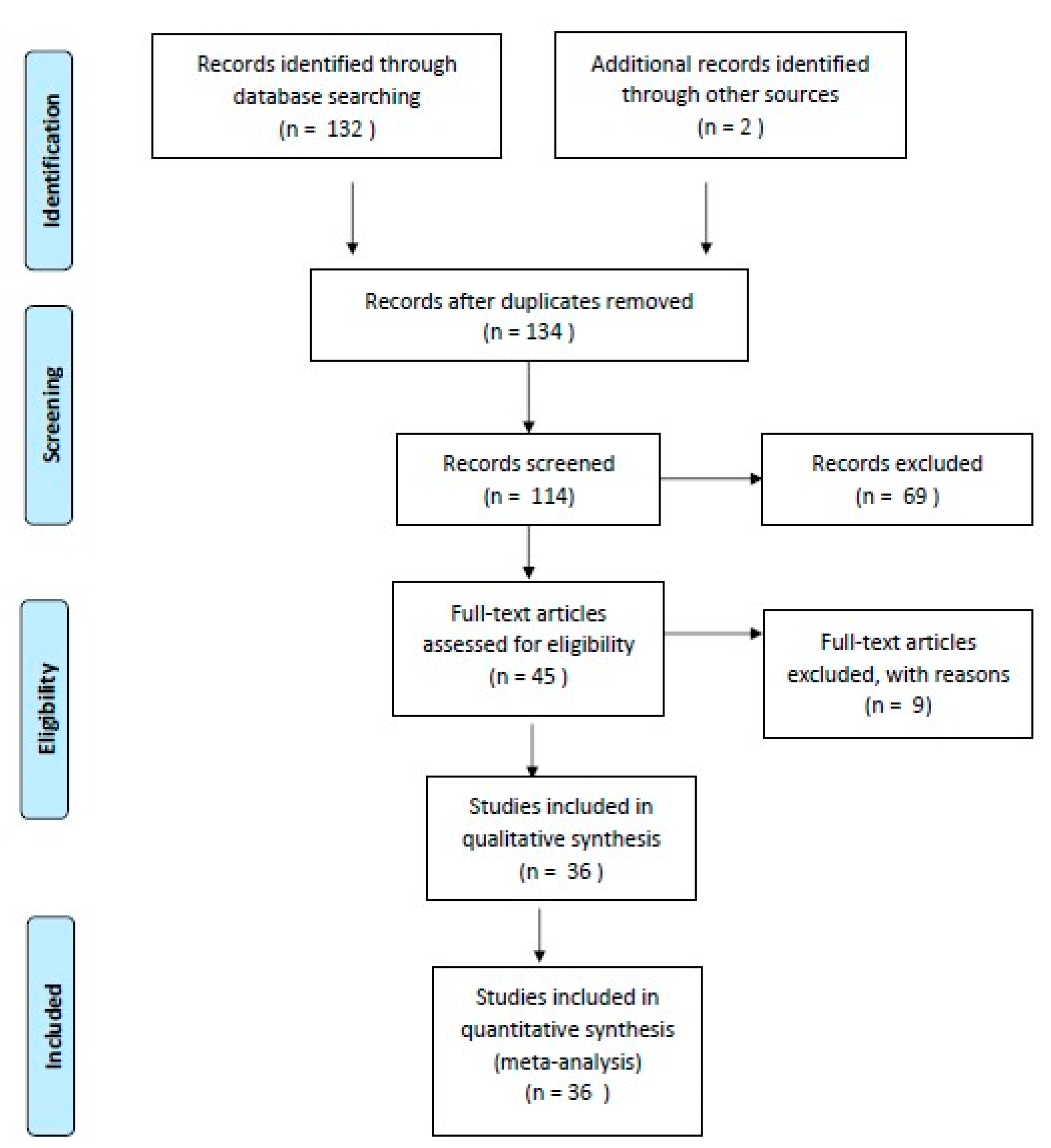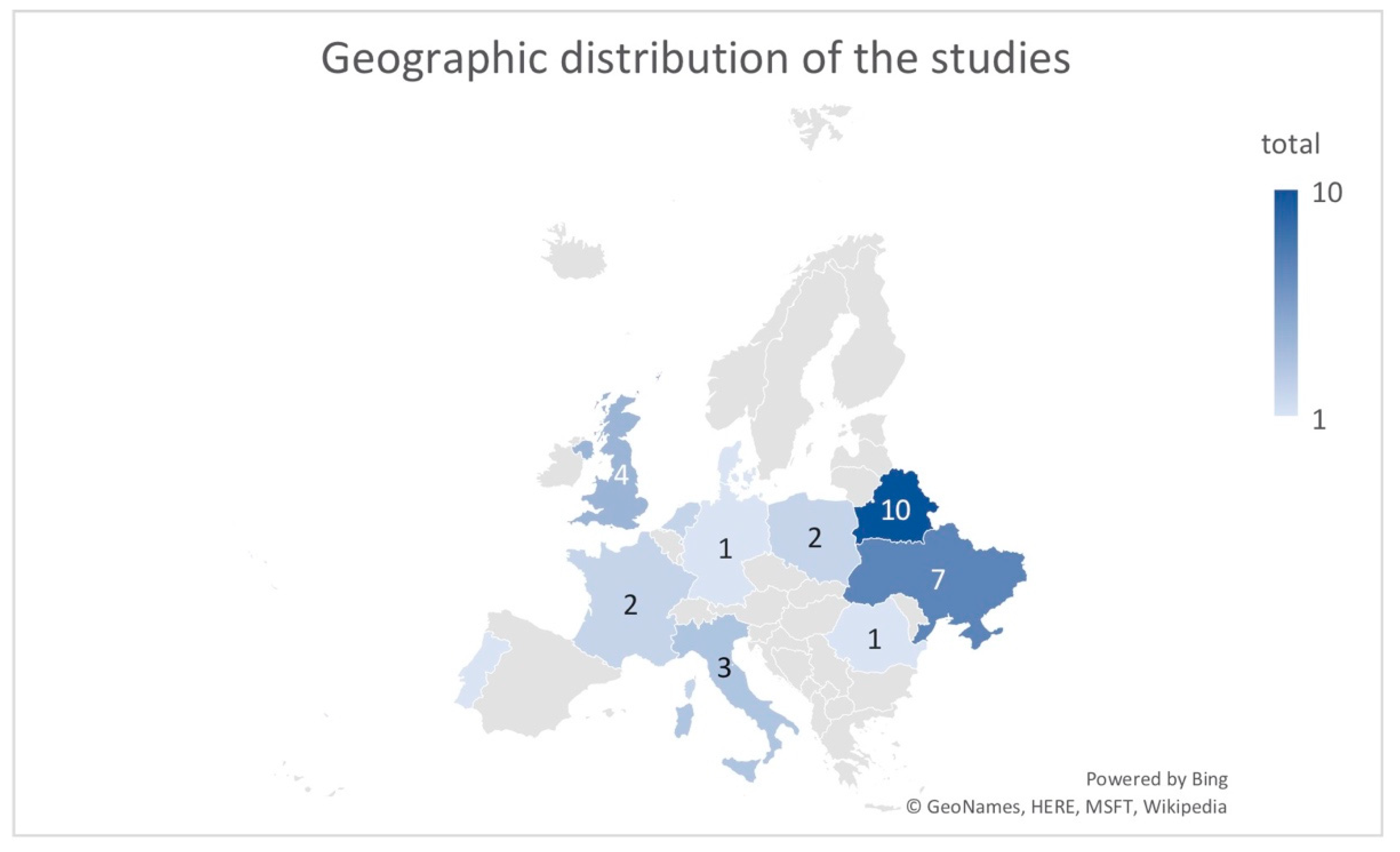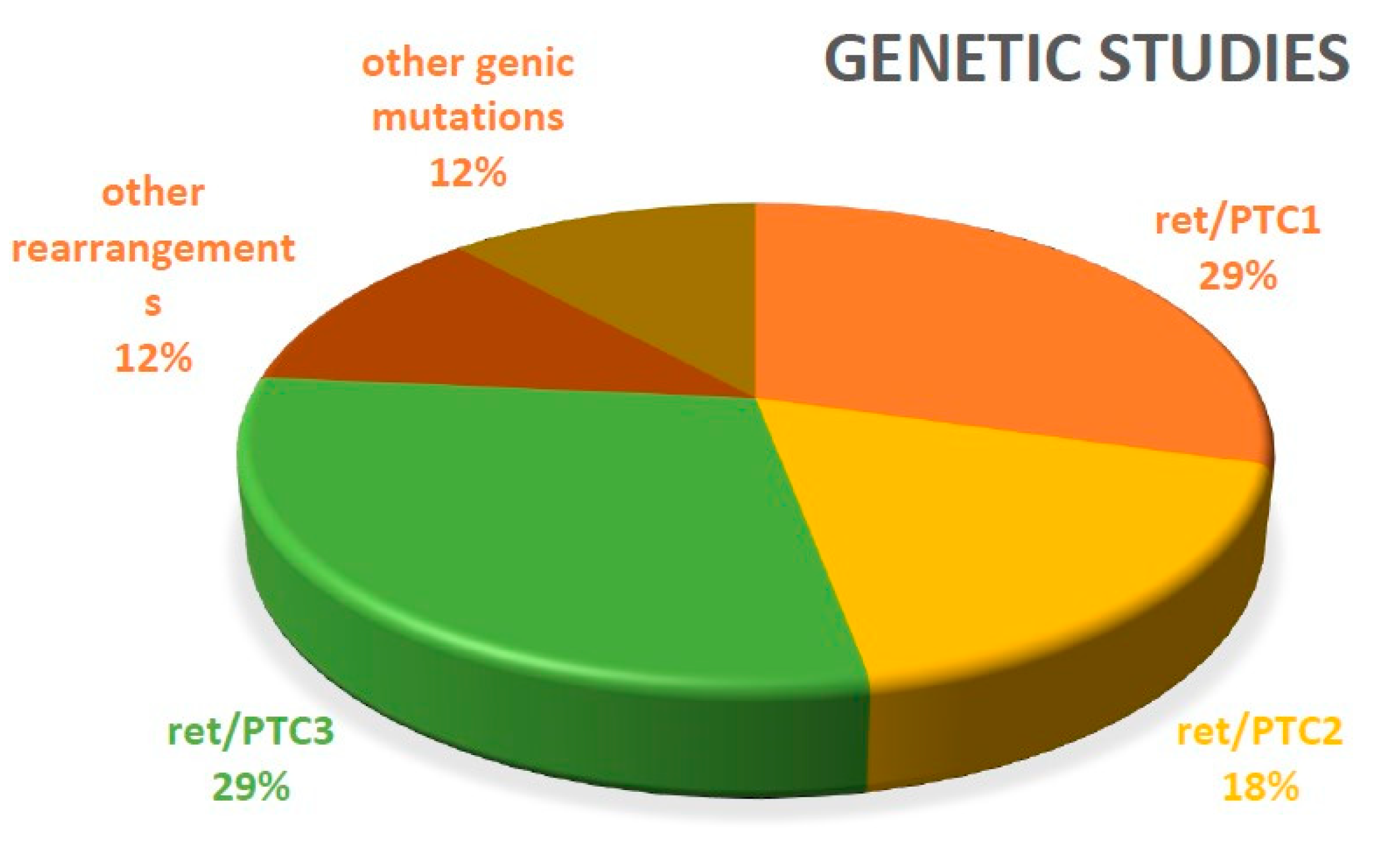Pediatric Thyroid Cancer in Europe: An Overdiagnosed Condition? A Literature Review
Abstract
:1. Introduction
2. Materials and Methods
3. Results
3.1. Epidemiology
3.2. Histology
3.3. Genetics
4. Discussions
Author Contributions
Funding
Conflicts of Interest
References
- Dekker, B.L.; Newbold, L.; Führer, D. Survey on Paediatric Differentiated Thyroid Cancer Care in Europe. Horm. Res. Paediatr. 2018, 89, 58–62. [Google Scholar] [CrossRef]
- Niedziela, M.; Korman, E.; Breborowicz, D.; Trejster, E.; Harasymczuk, J.; Warzywoda, M.; Rolski, M.; Breborowicz, J. A Prospective Study of Thyroid Nodular Disease in Children and Adolescents in Western Poland from 1996 to 2000 and the Incidence of Thyroid Carcinoma Relative to Iodine Deficiency and the Chernobyl Disaster. Med. Pediatr. Oncol. 2004, 42, 84–92. [Google Scholar] [CrossRef] [PubMed]
- Russo, M.; Malandrino, P.; Moleti, M.; Angelo, A.D.; Tavarelli, M.; Sapuppo, G.; Giani, F.; Richiusa, P.; Squatrito, S.; Vigneri, R.; et al. Thyroid Cancer in the Pediatric Age in Sicily: Influence of the Volcanic Environment. Anticancer Res. 2017, 37, 1515–1522. [Google Scholar] [PubMed] [Green Version]
- Drozd, V.M.; Saenko, V.A.; Brenner, A.V.; Drozdovitch, V.; Pashkevich, V.I.; Kudelsky, A.V.; Demidchik, Y.E.; Branovan, I.; Shiglik, N.; Rogounovitch, T.I.; et al. Major Factors Affecting Incidence of Childhood Thyroid Cancer in Belarus after the Chernobyl Accident: Do Nitrates in Drinking Water Play a Role? PLoS ONE 2015, 10, e0137226. [Google Scholar] [CrossRef] [PubMed]
- Piciu, D.; Piciu, A.; Irimie, A. Thyroid cancer in children: A 20-year study at a Romanian oncology institute. Endocr. J. 2012, 59, 489–496. [Google Scholar] [CrossRef] [PubMed] [Green Version]
- Thomas, G.A.; Bunnell, H.; Cook, H.A.; Williams, E.D.; Nerovnya, A.; Cherstvoy, D.; Tronko, N.D.; Bogdanova, T.I.; Chiappetta, G. High Prevalence of RET/PTC Rearrangements in Ukrainian and Belarussian Post-Chernobyl Thyroid Papillary Carcinomas: A Strong Correlation between Ret/PTC3 and the Solid-Follicular Variant. J. Clin. Endocrinol. Metab. 1999, 84, 4232–4238. [Google Scholar] [CrossRef]
- Niedziela, M.; Korman, E. Thyroid Carcinoma in a Fourteen-Year-Old Boy with Graves Disease. Med. Pediatr. Oncol. 2002, 38, 290–291. [Google Scholar] [CrossRef]
- Francis, G.L.; Waguespack, S.G.; Bauer, A.J.; Angelos, P.; Benvenga, S.; Cerutti, J.M.; Dinauer, C.A.; Hamilton, J.; Hay, I.D.; Luster, M. Management Guidelines for Children with Thyroid Nodules and Differentiates Thyroid Cancer. Thyroid 2015, 25, 716–759. [Google Scholar] [CrossRef] [Green Version]
- Bucsky, P.; Parlowsky, T. Endocrinology Epidemiology and therapy of thyroid cancer in childhood and adolescence. Exp. Clin. Endocrinol. Diabetes 1997, 105, 1995–1998. [Google Scholar]
- Pisani, P.; Buzzoni, C.; Crocetti, E.; Maso, L.D.; Rondelli, R.; Alessi, D.; Aricò, M.; Bidoli, E.; Ferrari, A.; Fusco, M.; et al. Italian cancer figures—Report 2012. Cancer in children and adolescents. Epidemiol. Prev. 2013, 37, 144–149. [Google Scholar]
- Collini, P.; Massimino, M.; Leite, S.F.; Mattavelli, F.; Fossati-Bellani, F.; Rosai, J. Papillary Thyroid Carcinoma of Childhood and Adolescence: A 30-Year Experience at the Istituto Nazionale Tumori in Milan. Pediatr. Blood Cancer 2006, 46, 300–306. [Google Scholar] [CrossRef] [PubMed]
- Hara, C.O.; Moran, A.; Whelan, J.S.; Hough, R.E.; Stiller, C.A.; Stevens, M.C.G. Trends in survival for teenagers and young adults with cancer in the UK 1992–2006. Eur. J. Cancer 2015, 51, 2039–2048. [Google Scholar]
- Reiners, C.; Biko, J.; Haenscheid, H.; Hebestreit, H.; Kirinjuk, S.; Baranowski, O.; Marlowe, R.J.; Demidchik, E.; Drozd, V.; Demidchik, Y. Twenty-Five Years After Chernobyl: Outcome of Radioiodine Treatment in Children and Adolescents with Very High-Risk Radiation-Induced Differentiated Thyroid Carcinoma. Endocr. Res. 2013, 98, 3039–3048. [Google Scholar] [CrossRef] [PubMed] [Green Version]
- Hesselink, M.S.K.; Nies, M.; Bocca, G.; Brouwers, A.H.; Burgerhof, J.G.M.; Dam, E.W.C.M.; van Havekes, B.; Heuvel-eibrink, M.M.; van Den Corssmit, E.P.M.; Peeters, R.P.; et al. Pediatric Differentiated Thyroid Carcinoma in The Netherlands: A Nationwide Follow-Up Study. J. Endocrinol. Metab. 2016, 101, 2031–2039. [Google Scholar] [CrossRef] [Green Version]
- American Joint Committee on Cancer. AJCC Cancer Staging Manual, 8th ed.; Amin, M.B., Edge, S.B., Green, F.L., Schilsky, R.L., Gaspar, L.E., Washington, M., KayâSullivan, D.C., Brookland, R.K., Brierley, J.D., Balch, C.M., et al., Eds.; Springer: New York, NY, USA, 2017; ISBN 9783319406176. [Google Scholar]
- Douglas, C.M.; Macgregor, F.B. Paediatric thyroid cancer: The Scottish experience. Scott. Med. J. 2015, 58, 34–40. [Google Scholar] [CrossRef]
- Tuttle, R.M.; Vaisman, F.; Tronko, M.D. Clinical Presentation and Clinical Outcomes in Chernobyl-related Paediatric Thyroid Cancers: What Do We Know Now? What Can We Expect in the Future? Clin. Oncol. 2011, 23, 268–275. [Google Scholar] [CrossRef]
- Piciu, D. The Thyroid Gland. In Nuclear Endocrinology; Springer: Berlin/Heidelberg, Germany, 2018; Volume 1, pp. 53–162. ISBN 9788578110796. [Google Scholar]
- Silva-Vieira, M.; Santos, R.; Leite, V.; Limbert, E. International Journal of Pediatric Otorhinolaryngology Review of clinical and pathological features of 93 cases of well-differentiated thyroid carcinoma in pediatric age at the Lisbon Centre of the Portuguese Institute of Oncology between 1964 and 2006. Int. J. Pediatr. Otorhinolaryngol. 2015, 79, 1324–1329. [Google Scholar] [CrossRef]
- Piciu, D. Thyroid cancer incidence 25 years after Chernobyl, in a Romanian cancer center: Is it a public health problem? Curr. Radiopharm. 2013, 6, 249–252. [Google Scholar] [CrossRef]
- Piciu, D.; Irimie, A.; Piciu, A. Investigation of thyroid carcinoma over 40 years, using the database of the Ion Chiricuta Institute of Oncology Cluj-Napoca. J. BUON 2014, 19, 524–529. [Google Scholar]
- Ito, M.; Yamashita, S.; Sekinel, I.; Kotova, L.; Panasyuk, G.; Demidchik, E.P.; Nagatak, S. Histopatological Characteristics of Childhood Thyroid Cancer in Gomel, Belarus. Int. J. Cancer 1996, 65, 29–33. [Google Scholar] [CrossRef]
- Nikiforov, Y.E.; Rowland, J.M.; Bove, K.E.; Monforte-Munoz, H.; Fagin, J.A. Distinct Pattern of ret Oncogene Rearrangements in Morphological Variants of Radiation-Induced and Sporadic Thyroid Papillary Carcinomas in Children. Cancer Res. 1997, 57, 1690–1695. [Google Scholar] [PubMed]
- Schwenn, M.R.; Brill, B. Childhood cancer 10 years after the Chernobyl accident. Curr. Opin. Pediatr. 1997, 9, 51–54. [Google Scholar] [CrossRef] [PubMed]
- Furmanchuk, A.W.; Averkin, J.I.; Egloff, B.; Ruchti, C.; Abelin, T.; Schappi, W.; Korotkevich, E.A. Pathomorphological findings in thyroid cancers of children from the Republic of Belarus: A study of 86 cases occuring between 1986 (post-Chernobyl) and 1991. Histopathology 1992, 21, 401–408. [Google Scholar] [CrossRef] [PubMed]
- Zimmerman, D. Thyroid neoplasia in children.pdf. Curr. Opin. Pediatr. 1997, 9, 413–418. [Google Scholar] [CrossRef]
- Nikiforov, Y.E.; Nikiforova, M.; Fagin, J.A. Prevalence of minisatellite and microsatellite instability in radiation-induced post-Chernobyl pediatric thyroid carcinomas. Oncogene 1998, 17, 1983–1988. [Google Scholar] [CrossRef] [Green Version]
- Fenton, C.L.; Lukes, Y.; Nicholson, D.; Dinauer, C.A.; Francis, G.L.; Tuttle, R.M. The Ret/PTC Mutations Are Common in Sporadic Papillary Thyroid Carcinoma of Children and Young Adults. J. Clin. Endocrinol. Metab. 2000, 85, 1170–1175. [Google Scholar] [CrossRef]
- Marks, S.; Girgis, R.; Couch, R. Thyroid Cancer in a Child Born After the Chernobyl Disaster. Lancet Oncol. 2002, 3, 527–528. [Google Scholar] [CrossRef]
- Ito, M.; Nakashima, M.; Nakayama, T.; Ohtsuru, A.; Nagayama, Y.; Takamura, N.; Demedchik, E.P.; Sekine, I.; Yamashita, S. Expressio of Receptor-Type Tyrosine Kinase, Axl and its Ligand, Gas6 in Pediatric Thyroid Carcinomas Around Chernobyl. Thyroid 2002, 12, 971–975. [Google Scholar] [CrossRef]
- Moysich, K.B.; Menezes, R.J.; Michalek, A.M. Chernobyl-related ionising radiation exposure and cancer risk: An epidemiological review. Lancet Oncol. 2002, 3, 269–279. [Google Scholar] [CrossRef]
- Di cristofaro, J.; Vasko, V.; Savchenko, V.; Cherenko, S.; Larin, A.; Ringel, M.D.; Saji, M.; Marcy, M.; Henry, J.F.; Carayon, P.; et al. Ret/PTC1 and Ret/PTC3 in thyroid tumors from Chernobyl liquidators: Comparison with sporadic tumors from Ukrainian and French patients. Endocr. Relat. Cancer 2005, 12, 173–183. [Google Scholar] [CrossRef]
- Stiller, C.A.; Marcos-Gragera, R.; Ardanaz, E.; Pannelli, F.; Marques, E.A.; Canada Martinez, A.; Steliarova-Foucher, E. Geographical patterns of childhood cancer incidence in Europe, 1988–1997. Report from the Automated Childhood Cancer Information System project. Eur. J. Cancer 2006, 42, 1952–1960. [Google Scholar] [CrossRef] [PubMed]
- Stein, L.; Rothschild, J.; Luce, J.; Cowell, J.K.; Thomas, G.; Bogdanova, T.; Tronko, M.D.; Hawthorn, L. Copy Number and Gene Expression Alterations in Radiation-Induced Papillary Thyroid Carcinoma from Chernobyl Pediatric Patients. Thyroid 2010, 20, 475–487. [Google Scholar] [CrossRef] [PubMed]
- Cardis, E.; Howe, G.; Ron, E.; Bebeshko, V.; Bogdanova, T.; Bouville, A.; Carr, Z.; Chumak, V.; Davis, S.; Demidchik, Y.; et al. Cancer consequences of the Chernobyl accident: 20 years on. J. Radiol. Prot. 2006, 26, 127–140. [Google Scholar] [CrossRef] [PubMed]
- Redlich, A.; Boxberger, N.; Schmid, K.W.; Frühwald, M.; Rohrer, T.; Vorwerk, P. Sensitivity of fine-needle biopsy in detecting pediatric differentiated thyroid carcinoma. Pediatr Blood Cancer. 2012, 59, 233–237. [Google Scholar] [CrossRef]
- Ricarte-Filho, J.C.; Li, S.; Garcia-Rendueles, M.E.R.; Montero-Conde, C.; Voza, F.; Knauf, J.A.; Heguy, A.; Viale, A.; Bogdanova, T.; Thomas, G.A.; et al. Identification of kinase fusion oncogenes in post-Chernobyl radiation-induced thyroid cancers. J. Clin. Investig. 2013, 123, 4935–4944. [Google Scholar] [CrossRef] [Green Version]
- Fridman, M.; Savva, N.; Krasko, O.; Mankovskaya, S.; Branovan, D.I.; Schmid, K.W.; Demidchik, Y. Initial Presentation and Late Results of Treatment of Post-Chernobyl Papillary Thyroid Carcinoma in Children and Adolescents of Belarus. Endocr. Res. 2014, 99, 2932–2941. [Google Scholar] [CrossRef] [Green Version]
- Desandes, E.; Lacour, B.; Clavel, J. Les cancers des adolescents et des jeunes patients: Vision épidémiologique et organisations des soins en France. Bull. Cancer 2016, 103, 957–965. [Google Scholar] [CrossRef]
- Bogdanova, T.I.; Saenko, V.A.; Hirokawa, M.; Ito, M.; Tronko, M.D.; Yamashita, S. Comparative histopathological analysis of sporadic pediatric papillary thyroid carcinoma from Japan and Ukraine. Endocr. J. 2017, 64, 977–993. [Google Scholar] [CrossRef] [Green Version]
- Grønhøj, C.; Mirian, C.; Friborg, J.; Hjalgrim, L.; Laier, G.H.; Von Buchwald, C.; Jakobsen, K.K.; Kiss, K.; Hjuler, T.; Charabi, B.; et al. Incidence of head and neck cancer in children: A Danish nationwide study from 1978 to 2014. Pediatr. Blood Cancer 2018, 65, e27037. [Google Scholar] [CrossRef]
- Hay, I.D.; Gonzalez-Losada, T.; Reinalda, M.S.; Honetschlager, J.A.; Richards, M.L.; Thompson, G.B. Long-term outcome in 215 children and adolescents with papillary thyroid cancer treated during 1940 through 2008. World J. Surg. 2010, 34, 1192–1202. [Google Scholar] [CrossRef]
- Pawelczak, M.; David, R.; Franklin, B.; Kessler, M.; Lam, L.; Shah, B. Outcomes of children and adolescents with well-differentiated thyroid carcinoma and pulmonary metastases following 131I treatment: A systematic review. Thyroid 2010, 20, 1095–1101. [Google Scholar] [CrossRef]
- Karapanou, O.; Tzanela, M.; Vlassopoulou, B.; Kanaka-Gantenbein, C. Differentiated thyroid cancer in childhood: A literature update. Hormones (Athens) 2017, 16, 381–387. [Google Scholar] [PubMed] [Green Version]
- Fernandez, R.M.; Borrego, S.; Cabello, R. Genetic disorders of pediatric MEN2A patients in the south of Spain. Clin. Transl. Oncol. 2014, 16, 1018–1021. [Google Scholar]
- Shen, X.; Zhu, G.; Liu, R.; Viola, D.; Elisei, R.; Puxeddu, E.; Fugazzola, L.; Colombo, C.; Jarzab, B.; Czarniecka, A.; et al. Patient Age-Associated Mortality Risk Is Differentiated by BRAF V600E Status in Papillary Thyroid Cancer. J. Clin. Oncol. 2018, 36, 438–445. [Google Scholar] [CrossRef] [PubMed] [Green Version]
- Melo, M.; da Rocha Gaspar, A.; Cancela, G.E.P.; Sobrinho-Simões, M.; Soares, P. Age-Associated Mortality Risk in Papillary Thyroid Cancer: Does BRAF Make a Real Difference? J. Clin. Oncol. 2018, 36, 1455–1456. [Google Scholar] [CrossRef] [PubMed]
- Thomas, G. Radiation and Thyroid Cancer—An Overview. Radiat. Prot. Dosimetry 2018, 182, 53–57. [Google Scholar] [CrossRef]
- Dinets, A.; Hulchiy, M.; Sofiadis, A.; Ghaderi, M.; Hoog, A.; Larsson, C.; Zedenius, J. Clinical, genetic, and immunohistochemical characterization of 70 Ukrainian adult cases with post-Chornobyl papillary thyroid carcinoma. Eur. J. Endocrinol. 2012, 166, 1049–1060. [Google Scholar] [CrossRef]
- Galuppini, F.; Vianello, F.; Censi, S.; Barollo, S.; Bertazza, L.; Carducci, S.; Colato, C.; Manso, J.; Rugge, M.; Iacobone, M.; et al. Differentiated Thyroid Carcinoma in Pediatric Age: Genetic and Clinical Scenario. Front. Endocrinol. 2019, 10, 552. [Google Scholar] [CrossRef] [Green Version]
- Piciu, D.; Irimie, A. Diagnosis and treatment guidelines in thyroid carcinoma. European and American consensus adapted to Romania. Acta Endocrinol. Bucharest 2007, 3, 103–115. [Google Scholar] [CrossRef]




| No. | First Author’s Name | Year of Publication | Country of Study | Study Type | |
|---|---|---|---|---|---|
| Screening | |||||
| 1. | Ito, M. [22] | 1996 | Belarus | Retrospective | |
| 2. | Bucsky, P. [9] | 1997 | Germany | Review | |
| 3. | Nikiforov, Y.E. [23] | 1997 | Belarus | Retrospective | |
| 4. | Schwenn, M.R. [24] | 1997 | Europe | Review | |
| 5. | Furmanchuk, A.W. [25] | 1992 | Chernobyl area | Retrospective | |
| 6. | Zimmerman, D. [26] | 1997 | Europe | Review | |
| 7. | Nikiforov, Y.E. [27] | 1998 | Belarus | Retrospective | |
| 8. | Thomas, G.A. [6] | 1999 | Belarus and Ukraine | Prospective | |
| 9. | Fenton, C.L. [28] | 2000 | USA, Washington | Retrospective | |
| 10. | Marks, S. [29] | 2002 | Belarus, Ukraine, Canada | Case presentation | |
| 11. | Ito, M. [30] | 2002 | Belarus | Retrospective | |
| 12. | Niedziela, M. [7] | 2002 | Poland | Case presentation | |
| 13. | Moysich, K. [31] | 2002 | Belarus, Ukraine | Review | |
| 14. | Niedziela, M. [2] | 2004 | Poland | Prospective | |
| 15. | Cristofaro, J. [32] | 2005 | Ukraine, France | Retrospective | |
| 16. | Stiller, C.A. [33] | 2006 | UK, Europe | Retrospective | |
| 17. | Collini, P. [11] | 2006 | Italy | Retrospective | |
| 18. | Stein, L. [34] | 2010 | UK | Retrospective | |
| 19. | Cardis, E. [35] | 2006 | Chernobyl area | Review | |
| 20. | Tuttle, R. [17] | 2011 | Russia, Ukraine, Belarus | Review | |
| 21. | Piciu, D. [5] | 2012 | Romania | Retrospective | |
| 22. | Redlich, A. [36] | 2012 | Germany | Retrospective | |
| 23. | Ricarte-Filho, J. [37] | 2013 | Ukraine | Retrospective | |
| 24. | Pisani, P. [10] | 2013 | Italy | Retrospective | |
| 25. | Reiners, C. [13] | 2013 | Ukraine | Retrospective | |
| 26. | Fridman, M. [38] | 2014 | Belarus | Retrospective | |
| 27. | Drozd, V. [4] | 2015 | Belarus | Retrospective | |
| 28. | O Hara, C. [12] | 2015 | UK | Retrospective | |
| 29. | Silva-Vieira, M. [19] | 2015 | Portugal | Retrospective | |
| 30. | Douglas, C.M. [16] | 2015 | Scotland | Retrospective | |
| 31. | Desandes, E. [39] | 2016 | France | Retrospective | |
| 32. | Hesselink, M. [14] | 2016 | The Netherlands | Retrospective | |
| 33. | Bogdanova, T. [40] | 2017 | Ukraine, Japan | Retrospective | |
| 34. | Russo, M. [3] | 2017 | Sicily | Retrospective | |
| 35. | Dekker, B. [1] | 2018 | Europe | Retrospective | |
| 36. | Grønhøj, C. [41] | 2018 | Denmark | Retrospective |
© 2020 by the authors. Licensee MDPI, Basel, Switzerland. This article is an open access article distributed under the terms and conditions of the Creative Commons Attribution (CC BY) license (http://creativecommons.org/licenses/by/4.0/).
Share and Cite
Stefan, A.-I.; Piciu, A.; Mester, A.; Apostu, D.; Badan, M.; Badulescu, C.-I. Pediatric Thyroid Cancer in Europe: An Overdiagnosed Condition? A Literature Review. Diagnostics 2020, 10, 112. https://doi.org/10.3390/diagnostics10020112
Stefan A-I, Piciu A, Mester A, Apostu D, Badan M, Badulescu C-I. Pediatric Thyroid Cancer in Europe: An Overdiagnosed Condition? A Literature Review. Diagnostics. 2020; 10(2):112. https://doi.org/10.3390/diagnostics10020112
Chicago/Turabian StyleStefan, Andreea-Ioana, Andra Piciu, Alexandru Mester, Dragos Apostu, Marius Badan, and Claudiu-Iulian Badulescu. 2020. "Pediatric Thyroid Cancer in Europe: An Overdiagnosed Condition? A Literature Review" Diagnostics 10, no. 2: 112. https://doi.org/10.3390/diagnostics10020112
APA StyleStefan, A.-I., Piciu, A., Mester, A., Apostu, D., Badan, M., & Badulescu, C.-I. (2020). Pediatric Thyroid Cancer in Europe: An Overdiagnosed Condition? A Literature Review. Diagnostics, 10(2), 112. https://doi.org/10.3390/diagnostics10020112







